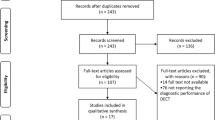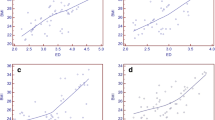Abstract
Objectives
The purpose of this study was to evaluate the impact of attenuation-based kilovoltage (kV) pair selection in dual source dual energy (DSDE)-pulmonary embolism (PE) protocol examinations on radiation dose savings and image quality.
Methods
A prospective study was carried out on 118 patients with suspected PE. In patients in whom attenuation-based kV pair selection selected the 80/140Sn kV pair, the pre-scan 100/140Sn CTDIvol (computed tomography dose index volume) values were compared with the pre-scan 80/140Sn CTDIvol values. Subjective and objective image quality parameters were assessed.
Results
Attenuation-based kV pair selection switched to the 80/140Sn kV pair (“switched” cohort) in 63 out of 118 patients (53%). The mean 100/140Sn pre-scan CTDIvol was 8.8 mGy, while the mean 80/140Sn pre-scan CTDIvol was 7.5 mGy. The average estimated dose reduction for the “switched” cohort was 1.3 mGy (95% CI 1.2, 1.4; p < 0.001), representing a 15% reduction in dose. After adjusting for patient weight, mean attenuation was significantly higher in the “switched” vs. “non-switched” cohorts in all five pulmonary arteries and in all lobes on iodine maps.
Conclusions
This study demonstrates that attenuation-based kV pair selection in DSDE examination is feasible and can offer radiation dose reduction without compromising image quality.
Key Points
• Attenuation-based kV pair selection in dual energy examination is feasible.
• It can offer radiation dose reduction to approximately 50% of patients.
• Approximate 15% reduction in radiation dose was achieved using this technique.
• The image quality is not compromised by use of attenuation-based kV pair selection.


Similar content being viewed by others
References
McCollough CH, Leng S, Yu L, Fletcher JG (2015) Dual- and multi-energy CT: principles, technical approaches, and clinical applications. Radiology 276:637–653
Kang MJ, Park CM, Lee CH, Goo JM, Lee HJ (2010) Dual-energy CT: clinical applications in various pulmonary diseases. Radiographics 30:685–698
Meinel FG, Nance JW Jr, Schoepf UJ, Hoffmann VS, Thierfelder KM, Costello P et al (2015) Predictive value of computed tomography in acute pulmonary embolism: systematic review and meta-analysis. Am J Med 128:747–59.e2
Fedullo P, Kerr KM, Kim NH, Auger WR (2011) Chronic thromboembolic pulmonary hypertension. Am J Respir Crit Care Med 183:1605–1613
Apfaltrer P, Bachmann V, Meyer M, Henzler T, Barraza JM, Gruettner J et al (2012) Prognostic value of perfusion defect volume at dual energy CTA in patients with pulmonary embolism: correlation with CTA obstruction scores, CT parameters of right ventricular dysfunction and adverse clinical outcome. Eur J Radiol 81:3592–3597
Sakamoto A, Sakamoto I, Nagayama H, Koike H, Sueyoshi E, Uetani M (2014) Quantification of lung perfusion blood volume with dual-energy CT: assessment of the severity of acute pulmonary thromboembolism. AJR Am J Roentgenol 203:287–291
Hoey ET, Mirsadraee S, Pepke-Zaba J, Jenkins DP, Gopalan D, Screaton NJ (2011) Dual-energy CT angiography for assessment of regional pulmonary perfusion in patients with chronic thromboembolic pulmonary hypertension: initial experience. AJR Am J Roentgenol 196:524–532
Kalra MK, Maher MM, Toth TL et al (2004) Strategies for CT radiation dose optimization. Radiology 230:619–628
McCollough CH, Bruesewitz MR, Kofler JM Jr (2006) CT dose reduction and dose management tools: overview of available options. Radiographics 26:503–512
Prakash P, Kalra MK, Kambadakone AK et al (2010) Reducing abdominal CT radiation dose with adaptive statistical iterative reconstruction technique. Invest Radiol 45:202–210
Soderberg M, Gunnarsson M (2010) Automatic exposure control in computed tomo-graphy – an evaluation of systems from different manufacturers. Acta Radiol 51:625–634
Sigal-Cinqualbre AB, Hennequin R, Abada HT, Chen X, Paul JF (2004) Low-kilovoltage multi-detector row chest CT in adults: feasibility and effect on image quality and iodine dose. Radiology 231:169–174
Sodickson A, Weiss M (2012) Effects of patient size on radiation dose reduction and image quality in low-kVp CT pulmonary angiography performed with reduced IV contrast dose. Emerg Radiol 19:437–44514
Spearman JV, Schoepf UJ, Rottenkolber M, Driesser I, Canstein C, Thierfelder KM et al (2016) Effect of automated attenuation-based tube voltage selection on radiation dose at CT: an observational study on global scale. Radiology 279:167–174
Eller A, Wuest W, Scharf M et al (2013) Attenuation-based automatic kilovolt (kV)-selection in computed tomography of the chest: effects on radiation exposure and image quality. Eur J Radiol 82:2386–2391
Winklehner A, Goetti R, Baumueller S et al (2011) Automated attenuation-based tube potential selection for thoracoabdominal computed tomography angiography: improved dose effectiveness. Invest Radiol 46:767–773
Niemann T, Henry S, Faivre JB, Yasunaga K, Bendaoud S, Simeone A et al (2013) Clinical evaluation of automatic tube voltage selection in chest CT angiography. Eur Radiol 23:2643–2651
Beeres M, Williams K, Bauer RW, Scholtz J, Kaup M, Gruber-Rouh T et al (2015) First clinical evaluation of high-pitch dual-source computed tomographic angiography comparing automated tube potential selection with automated tube current modulation. J Comput Assist Tomogr 39:624–628
McCollough C, Bakalyar DM, Bostani M, Brady S, Boedeker K, Boone JM et al (2014) Use of water equivalent diameter for calculating patient size and size-specific dose estimates (SSDE) in CT: the report of AAPM Task Group 220. AAPM Rep 2014:6–23
Szucs-Farkas Z, Strautz T, Patak MA, Kurmann L, Vock P, Schindera ST (2009) Is body weight the most appropriate criterion to select patients eligible for low-dose pulmonary CT angiography? Analysis of objective and subjective image quality at 80 kVp in 100 patients. Eur Radiol 19:1914–1922
de Broucker T, Pontana F, Santangelo T, Faivre JB, Tacelli N, Delannoy-Deken et al (2012) Single- and dual-source chest CT protocols: levels of radiation dose in routine clinical practice. Diagn Interv Imaging 93:852–858
Schenzle JC, Sommer WH, Neumaier K, Michalski G, Lechel U, Nikolaou K et al (2010) Dual energy CT of the chest: how about the dose? Invest Radiol 45:347–353
Pontana F, Henry S, Duhamel A, Faivre JB, Tacelli N, Pagniez J et al (2015) Impact of iterative reconstruction on the diagnosis of acute pulmonary embolism (PE) on reduced-dose chest CT angiograms. Eur Radiol 25:1182–1189
Baker ME, Karim W, Bullen JA, Primak AN, Dong FF, Herts BR (2015) Estimated patient dose indexes in adult and pediatric MDCT: comparison of automatic tube voltage selection with fixed tube current, fixed tube voltage, and weight-based protocols. AJR Am J Roentgenol 205:592–598
Acknowledgements
The scientific guarantor of this publication is Rahul Renapurkar. The authors of this manuscript declare no relationships with any companies whose products or services may be related to the subject matter of the article. The authors state that this work has not received any funding. Ms Jennifer Bullen kindly provided statistical advice for this manuscript. Institutional review board approval was obtained. Written informed consent was waived by the institutional review board. Methodology: prospective, diagnostic or prognostic study, performed at one institution.
Author information
Authors and Affiliations
Corresponding author
Rights and permissions
About this article
Cite this article
Renapurkar, R.D., Primak, A., Azok, J. et al. Attenuation-based kV pair selection in dual source dual energy computed tomography angiography of the chest: impact on radiation dose and image quality. Eur Radiol 27, 3283–3289 (2017). https://doi.org/10.1007/s00330-016-4714-7
Received:
Revised:
Accepted:
Published:
Issue Date:
DOI: https://doi.org/10.1007/s00330-016-4714-7




